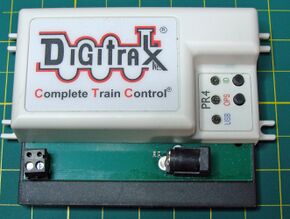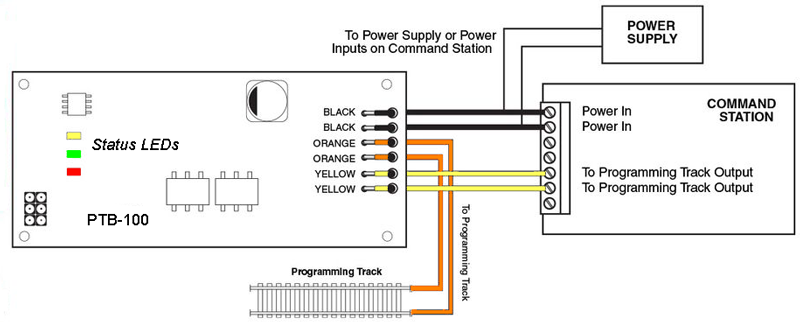PTB-100
Programming:
SoundTraxx: PTB-100Summary: SoundTraxx's programming track booster is used to program sound decoders when the programming outputs of the command station alone cannot.
| See more Misc DCC Items | |
|---|---|

| |
| General information | |
| DCC Category Programming | |
| Manufacturer | SoundTraxx |
| MSRP | 69.95 USD71.21 EUR <br />62.30 GBP <br />105.72 AUD <br />94.37 CAD <br /> |
| Compare Prices | Latest Prices |
| Manufacturer Part Number | 829002 |
| Common Name | |
| UPC Number | 812165021239 |
| Release information
| |
| Product URL | External Product Link |
| Product Manual URL | External Product Link |
| Has computer interface | None |
| Firmware Upgrade Possible | |
| Predecessor | |
| Successor | |
| Misc Details | |
| Height | |
| Length | |
| Width | |
PTB-100 Programming Track Booster
How to connect a PTB-100 to your programming track.
The PTB-100 is a small PCB with 6 leads (three pairs.)
They are connected as follows:
- Black pair, one to each of the power supply connections for your booster.
- An external power supply will also work. If the voltage is too low the PTB-100 may not work well.
- Orange pair, one to each rail of your programming track
- Yellow pair, one to each programming terminal on your booster
Note: recommended power supply is a maximum of 18VAC or 22VDC. Minimum input voltage for reliable operation is 12VAC or 14VDC. A dedicated 15VDC 500mA power supply will also work.
The PTB-100 can be permanently installed. See Programming Track for more information.
- Important
- The PTB-100 or any programming track booster is connected to the program track output of the booster. Never connect it to the Track outputs!
- The programming track outputs must never be connected to the main track power!
Operation
The PTB-100 will automatically connect to the programming track whenever you start programming operations. A small, surface mounted green LED indicates the status. Slow flashing means it is safe to place a locomotive on the track (no power). Once you change to programming mode, the LED may be lit constantly. Depending on your command station, it may stay on, or only come on during a programming operation, and return to a flashing state when the operation is complete.
- If the programming track is part of the layout, the PTB-100 must be physically disconnected from the track before normal track power is restored. See Programming Track.
- Only remove the locomotive when the green LED is flashing.
- The yellow LED blinks when DCC commands are being sent. If it doesn't there is something wrong. The decoder must be connected to a load (motor) for it to work.
- The red LED indicates a fault, such as a short, when blinking slowly. Remove the locomotive and wait 30 seconds for the reset cycle to complete. Rapid blinking indicates power supply voltage is too low.
PTB-100 Video
Notes
- According to SoundTraxx, a programming track booster is not needed with a Lenz LZV100 or Zimo's MX1 (no longer available).
- When programming a QSI decoder using JMRI DecoderPro, turn off the verbal response, as the commands are sent so quickly that the verbal response will cause problems.
- Do not use a programming track booster with NCE's Power Cab.
- A programming track booster may not be needed for the Soundtraxx Tsunami-2 (TSU-2) or Econami series DCC Decoders.
Connections
See Also
PTB-100 FAQs
- No FAQs link to this page.
See Also
Articles Referencing this Page
- Athearn Genesis With Tsunami TSU-1000
- Videos:CV Programming Myths
- Videos:Contents
- NCE Hints
- Power Cab
- Programming Track
- Short-Circuit Protection (decoder)
- User:Silverbackman/Books/DCC
